The 10 Most Insane Medical Practices in History
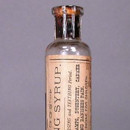
Cracked.com's new book is now on sale. What follows is one of 22 classic articles that appear in the book, along with 18 new articles that you can't read anywhere else.
Have you ever been left with the impression after a thorough poking, prodding and testicular cupping at the doctor's office that perhaps they don't always know what's best? The thought is usually pushed from your mind, after all these people had to go through years of school and thousands of dollars of their wealthy parents' money to get where they are! If you can't trust them about your health, who can you trust?
Here's the thing though, doctors have a long storied background of not knowing what the hell they're doing. History is filled with stories of hilarious medical ineptitude, and in all likeliness, today's medical practices will be similarly snorted at 100 years down the road. In other words, if you're looking to justify your medical phobia so you can rationalize not getting that ever-growing lump on your neck checked out, you're in the right place.
Children's Soothing Syrups

In the 19th century, people were simply too busy churning butter, waxing their moustaches or changing in and out of 15 layers of undergarments every time they went to take a piss to be bothered with disobedient children. To aide the stressed 19th-century mother, a series of "soothing syrups," lozenges and powders were created, all which were carefully formulated to ensure they were safe for use by those most vulnerable members of the family. Oh, no, wait. Actually, they pumped each bottle full of as many narcotics as it could hold.
For instance, each ounce of Mrs. Winslow's Soothing Syrup contained 65 mg of pure morphine.

Based on our experiences teething and experimenting with pure morphine, that seems like a lot. Finally in 1910 the New York Times decided the whole narcotic-babysitter concept was probably bad in the long run, and ran an article pointing out that these soothing syrups contained, "...morphin sulphate, chloroform, morphine hydrochloride, codeine, heroin, powdered opium, cannabis indica," and sometimes several of them in combination.

You can't say the soothing syrups weren't effective, as long as you didn't mind your toddler being strung out on the midnight oil or, you know, dead. That's right, the terrible 2s weren't just a cutesy euphemism back then. Kids were not only at their brattiest but also often died, in many cases after their parents tried to cure the aforementioned brattiness with narcotic concoctions that would give Lindsay Lohan a nose bleed.
The Curative Powers of Mercury
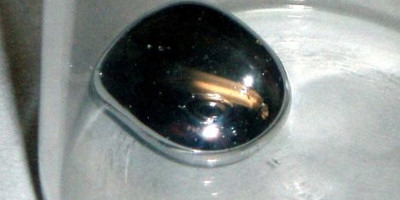
Mercury is pretty neat stuff. The shiny silvery liquid has fascinated humans for millennia (there's evidence people used it as early as 1500 BC) and will undoubtedly continue to fascinate far into the future when shape-shifting Robert Patrick clones overtake the planet. How could something so awesome not be good for you?
That was the thinking for centuries, when Mercury was used to treat pretty much anything and everything. Scraped your knee? Just rub a little mercury on it. Having some problems with regularity? Forget fiber, time to get some mercury up in there! If you lived more than 100 years ago, you simply weren't considered healthy if you weren't leaking silver from at least one orifice.
Mercury, as we now know, is toxic as hell. Symptoms of mercury poisoning include chest pains, heart and lung problems, coughing, tremors, violent muscle spasms, psychotic reactions, delirium, hallucinations, suicidal tendencies, restless spleen syndrome, testicular twisting and anal implosion. OK, we just made the last few up, but they barely looked out of place on that horror show list of symptoms did they?
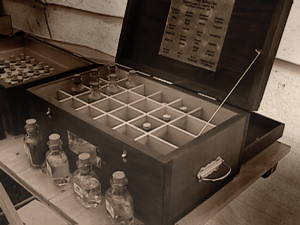
It's a testament to just how cool a substance Mercury is that people kept trying to cure shit with it for 1,000 years after everybody who ingested it dropped dead. "Yes my Lord, I'm afraid another member of your court has perished. The autopsy showed it was Silver Liver Syndrome. Not even the gallons of wicked-awesome Mercury we fed him could bring him back to health."
There was a silver lining, though, as it helped to fight the spread of STDs. Mercury was used as a cure for syphilis and to its credit, the "cure" usually resulted in one less person with syphilis in the world. It's generally believed Mozart was poisoned by mercury-based syphilis cures, which contradicts the film Amadeus in which he was killed by writing too much music somehow.
Calm Your Cough with Heroin

In the late 19th century people apparently took cough suppression seriously. We're talking "I'm-going-to-take-me- some-heroin-to-calm-this-cough" level serious, here. We know Victorians were sticklers for social etiquette and wheezing your head off was probably considered frightfully rude, but we can't imagine tying off and shooting some horse in the middle of a dinner party would go over terribly well, either.
Well you probably don't need us to tell you how addictive and destructive a drug heroin really is, but just in case ... Heroin? Might want to avoid that stuff. On the upside, it actually does suppress coughs, so if you do decide to become a junkie at least you'll save on buying Halls.
 Heroin, by the way, was originally developed by Bayer. You know, those friendly folks behind harmless old aspirin.
Heroin, by the way, was originally developed by Bayer. You know, those friendly folks behind harmless old aspirin.
Oh, and while we're taking on the man, we should also mention that Bayer used to be called IG Farben, a pharmaceutical and chemical conglomerate that allegedly sponsored experiments by Nazi torturers. How is this not at the center of every single Tylenol ad campaign: the fast acting pain reliever that has never sponsored Nazi torture camps.
Electrical Impotence Cures

Men have been desperately searching for solutions to their malfunctioning members since Grok the caveman clubbed a cavewoman, drug her to his cave only to drag her back out again a half hour later with an embarrassed look on his face and muttering excuses about how tired he is. In the late 19th century, the wonders of electricity became to be known to the common person. Surely this marvelous new technology could be used to heat things up in the boudoir, right?
Electrified beds, elaborate cock shocking electric belts and other strange devices were advertised as being able to return "male power" and prowess by making your penis rise to electrified attention like Frankenstein's 6-inch-tall monster.
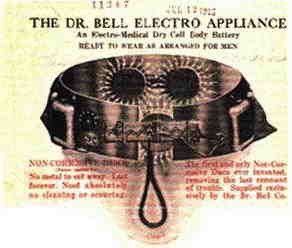
Photo courtesy of The Museum of Quackery.
What's fascinating is that you can find ads for more than one brand of electric dick-shock belt. That seems to indicate that the dick-shock belt industry somehow survived the negative word of mouth from the first dick-shock belt.
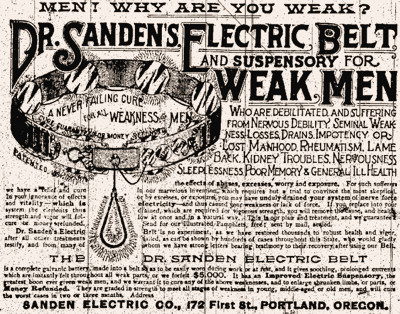
Lobotomies

Imagine if you will. You're sitting on your psychiatrist's couch, pouring your tortured heart out about how depressed you are. He listens, jotting notes on a piece of paper and nodding intently. "I think I have the solution to your depression," he says as he produces a 10-inch-long ice pick. "I'm going to jam this into your eye socket, then put it into your brain using this mallet over here. Then, I'll wiggle it around so that it shreds part of your brain. Then you won't be depressed any more. Just lie still."
Congratulations hypothetical version of yourself living in the 1940s, you've just been lobotomized! Lobotomies were a popular fad for the first half of the 20th century and were floated as a "cure" for pretty much any mental issue you can name, from conditions as serious as schizophrenia to something as mild as depression or anxiety.

The inventor of the lobotomy was given a Nobel Prize for it in 1949. Doctors claimed the "ice-pick-to-the- freaking-eye" method of lobotomy would be as quick and easy as a trip to the dentist. By 1960, parents were getting them for their moody teenage children.
This practice didn't hang around as long as some on our list, but still some 70,000 people were lobotomized before somebody figured out that driving a spike into the brain probably was not the answer to all of life's problems.
Urine Therapy

You can tell just by the title of the entry that we're not heading anywhere good with this one. Yup, throughout history there are those who believed the key to good health (and terrible body odor) was wallowing in one's own excretions. It was said to cure an endless list of ailments and promote good health if drank, was applied to the skin and yes some even used it to give themselves (turn away now weak-of-heart) a nice bracing urine enema.
 Perhaps the best part of this is that while most of the practices listed in this article have long since been dismissed as lunacy, urine therapy lives on to today (for your own sanity don't do a Google search for it). That's right, of all the crackpot theories listed here the one that endured is the one where people drink and bathe in piss.
Perhaps the best part of this is that while most of the practices listed in this article have long since been dismissed as lunacy, urine therapy lives on to today (for your own sanity don't do a Google search for it). That's right, of all the crackpot theories listed here the one that endured is the one where people drink and bathe in piss.
There's absolutely no evidence that urine therapy can cure a damn thing (and it comes with the added bonus of you getting to smell like the underside of a bridge or a downtown subway car). No, even the thing with peeing on jellyfish stings isn't true. On the bright side, armed with the new knowledge we've provided you, you can now try to pass those DVDs your girlfriend found in your closet off as medical instruction videos.
Bloodletting
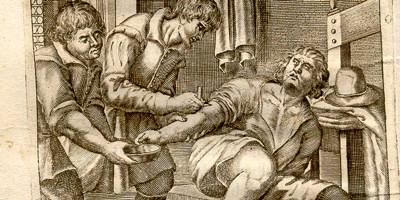
Bloodletting was one of the most enduring and popular medical practices in history, originated by the Greeks and used up until the 19th century for, well, basically everything. If you were feeling under the weather back in the day there's a good chance it was because you just had too much damn blood.
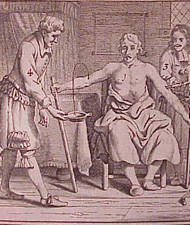 Now, a person having too much blood may sound about as absurd as a person breathing too much air or you coming home to find too many naked supermodels in your bed. But, that's just because you don't know about the four humours. Don't worry, we won't hold your ignorance against you. Basically the theory was that the body was filled with four fluids (blood, phlegm, yellow bile and black bile) called humours and that any imbalance in the four was the root of all illness. Apparently blood can be a bit of a space hog and thus often some had to be bled out to make room for more fun stuff like phlegm and black bile (a.k.a. diarrhea), or so the theory went.
Now, a person having too much blood may sound about as absurd as a person breathing too much air or you coming home to find too many naked supermodels in your bed. But, that's just because you don't know about the four humours. Don't worry, we won't hold your ignorance against you. Basically the theory was that the body was filled with four fluids (blood, phlegm, yellow bile and black bile) called humours and that any imbalance in the four was the root of all illness. Apparently blood can be a bit of a space hog and thus often some had to be bled out to make room for more fun stuff like phlegm and black bile (a.k.a. diarrhea), or so the theory went.
If you're wondering whether or not it works, the next time you're on your death bed with the flu, drag yourself out of bed and go downtown and give anywhere up to 4 quarts of blood; that's bloodletting for you, except you usually didn't get orange juice and a cookie after. Now, there is a chance you'll feel a bit better as you take a delirious blood loss inspired trip through the clouds on a golden unicorn, but we can assure you your flu probably won't be cured.
Hard Core Diet Remedies

While fuller figures have been popular for most of history, during the 20th century thin was in for women (which explains why it's known today as the "no fat chicks" century. Well, at least by us). This need to be slim led to the creation of countless "diet pills" that promised to help you melt away those pounds and inches.
While a lot of the pills actually did help with weight loss, they also often caused fevers, heart troubles, blindness, death and birth defects. They couldn't have been all bad though, as in the 1950s and '60s women who took diet pills liked them so darn much they just couldn't seem to stop taking them. Of course, it might have had something to do with the fact that the diet pills of the '50s and '60s were in actuality bottles of pure crank. But hey, what's getting addicted to amphetamines when being ready for bathing suit season hangs in the balance?
Oh, and since we just can't resist grossing you fine readers out, there have long existed stories that in the 1920s and '30s capsules filled with dehydrated tapeworms or tapeworm eggs were sold as diet pills.

Photo courtesy of The Museum of Quackery.
There's some debate over whether these actually existed, but it seems like it could be true as various advertisements for the wormy pills have survived. Besides, if there was a market for the nut shock belt ...
Trepanation
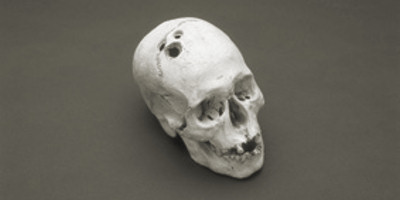
Trepanation is a fancy word for drilling holes in your head. This is actually the oldest surgical procedure known to man as humans have been intentionally knocking holes in their skulls dating back to the time of cavemen, giving hope to anyone who's had to watch the sitcom starring the Geico cavemen that all of them might die in a trepanation experiment horribly gone wrong in an upcoming episode.
 Historically trepanation was most commonly used as treatment for seizures and migraines. Surprise, surprise. Having a gaping hole drilled in your skull (usually without anesthesia) did very little to help people's headaches or brain issues. Trepanation was also used as an extreme form of cosmetic/experimental body modification amongst several societies such as the Incans and Mayans. These societies also got largely wiped out, then a few hundred years later suffered the indignity of having an insulting Mel Gibson movie made about them, so it didn't really work out that well.
Historically trepanation was most commonly used as treatment for seizures and migraines. Surprise, surprise. Having a gaping hole drilled in your skull (usually without anesthesia) did very little to help people's headaches or brain issues. Trepanation was also used as an extreme form of cosmetic/experimental body modification amongst several societies such as the Incans and Mayans. These societies also got largely wiped out, then a few hundred years later suffered the indignity of having an insulting Mel Gibson movie made about them, so it didn't really work out that well.
Oh, and yes, a few brilliant individuals still practice trepanation to this day. To give you an idea of the oh-so-solid ground today's trepanation supporters' beliefs are built on, the biggest modern proponent of trepanation is a "Doctor" Bart Hughes. We put doctor in quotations marks because he never actually finished medical school. That's right kids, you, too, can be a college dropout and yet still go onto a career convincing people around the world to do incredibly retarded things, so reach for those stars.
Female Hysteria Cures

Women and their mood swings, right guys? Right? You know what we're saying. Now, if you happen to be female don't be offended, there's no shame in admitting to the occasional bit of moodiness as according to 19th century doctors it's a symptom of a deadly serious medical condition (along with other symptoms such as nervousness, irritability and the dreaded "tendency to cause trouble"). That's right ladies, you may be a victim of female hysteria and not even know it.
 So, how exactly do you cure a so-called "condition" that coincidentally was diagnosed almost entirely to women who dared disobey their Victorian husbands? Glad you asked. The prescription for female hysteria was usually a good spot of doctor administered vaginal massage until the woman achieved "hysterical paroxysm."
So, how exactly do you cure a so-called "condition" that coincidentally was diagnosed almost entirely to women who dared disobey their Victorian husbands? Glad you asked. The prescription for female hysteria was usually a good spot of doctor administered vaginal massage until the woman achieved "hysterical paroxysm."
Yes that's right, the cure for female hysteria was a doctor's hand down your bloomers until you weren't only thinking of England but screaming its name. Is it any wonder the list of symptoms for female hysteria was so long, literally any ailment could fit the diagnosis? In those sexually repressed times visiting the doctor's office must have been like a trip to Disneyland for most women.

Doctors of the day on the other hand were apparently, I don't know, gay or something since they actually objected to women's frequent desire to be "cured" by their magic fingers. Their solution to alleviate hand strain? They invented the vibrator, and thus this article comes to a happy ending.
For more, go buy You Might Be a Zombie anywhere books are sold online or in person.
Nathan Birch also writes the sickeningly cute comic strip Zoology. He also wrote The 5 Creepiest urban Legends (That Happen to be True) for Cracked.